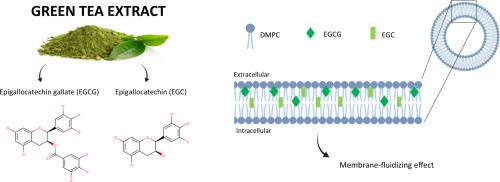Biochimica et Biophysica Acta (BBA) - Biomembranes ( IF 2.8 ) Pub Date : 2020-09-15 , DOI: 10.1016/j.bbamem.2020.183476 Stéphanie Andrade 1 , Joana Angélica Loureiro 1 , Maria Carmo Pereira 1

|
The interaction of antioxidants with biological membranes is closely related with their efficacy to inhibit the lipid peroxidation, the cause of several pathologies including cancer, neurodegenerative and cardiovascular disorders. Despite being pointed as a promising antioxidant agent by some authors, the anti-lipid peroxidation of green tea extract (GTE) has not aroused consensus among the scientific community. Since the interaction of drugs with biological membranes plays a key role on their therapeutic activity, this study aims to evaluate the interaction of GTE with liposomes as in vitro biomembrane models composed of 1,2-dimyristoyl-sn-glycero-3-phosphocholine phospholipids in the absence and presence of cholesterol (CHOL) (15 mol%). The affinity of GTE and its main components (−)-epigallocatechin gallate (EGCG) and (−)-epigallocatechin (EGC) to the lipid bilayer, their membrane location as well as their effect on the membrane fluidity was investigated by diverse biophysical techniques. Derivative spectrophotometry results proved that GTE has high affinity to the membrane by establishing hydrophobic interactions with the non-polar region of phospholipids and electrostatic interactions with the polar phospholipid heads. Fluorescence and dynamic light scattering data confirm that GTE is located in both hydrophobic and hydrophilic regions of the lipid membrane, therefore affecting the structure of the biomembrane by increasing its fluidity. However, the increased stiffness and organization of the lipid bilayer caused by CHOL significantly affected the interaction of GTE with the membrane. Moreover, the obtained findings suggest a direct contribution of EGCG and EGC on the GTE-membrane interaction.
中文翻译:

绿茶提取物与生物膜的相互作用研究:其两个主要成分的作用,(-)-表没食子儿茶素没食子酸酯和(-)-表没食子儿茶素。
抗氧化剂与生物膜的相互作用与它们抑制脂质过氧化的功效密切相关,脂质过氧化是几种病理的起因,包括癌症,神经退行性疾病和心血管疾病。尽管一些作者指出绿茶提取物的抗脂质过氧化作用被认为是一种有希望的抗氧化剂,但尚未引起科学界的共识。由于药物与生物膜的相互作用在其治疗活性中起着关键作用,因此本研究旨在评估体外GTE与脂质体的相互作用在不存在和存在胆固醇(CHOL)(15 mol%)的情况下,由1,2-二肉豆蔻酰基-sn-甘油-3-磷酸胆碱磷脂组成的生物膜模型。通过多种生物物理技术研究了GTE及其主要成分(-)-表没食子儿茶素没食子酸酯(EGCG)和(-)-表没食子儿茶素(EGC)对脂质双层的亲和力,它们的膜位置以及对膜流动性的影响。导数分光光度法结果证明,GTE通过与磷脂的非极性区域建立疏水相互作用以及与极性磷脂头形成静电相互作用,从而对膜具有高亲和力。荧光和动态光散射数据证实,GTE位于脂质膜的疏水和亲水区域,因此通过增加生物膜的流动性来影响其结构。然而,由CHOL引起的脂质双层的增加的刚度和组织显着影响了GTE与膜的相互作用。此外,获得的发现表明EGCG和EGC对GTE-膜相互作用的直接贡献。











































 京公网安备 11010802027423号
京公网安备 11010802027423号